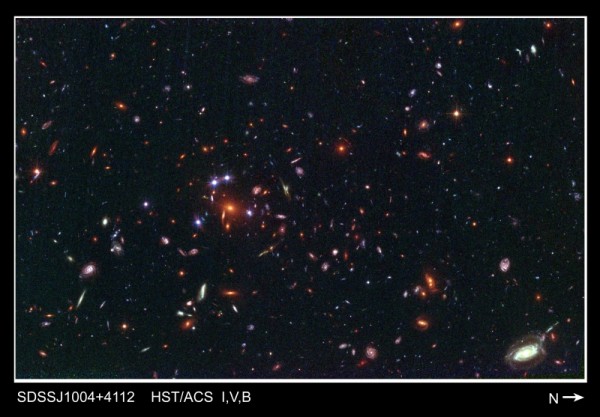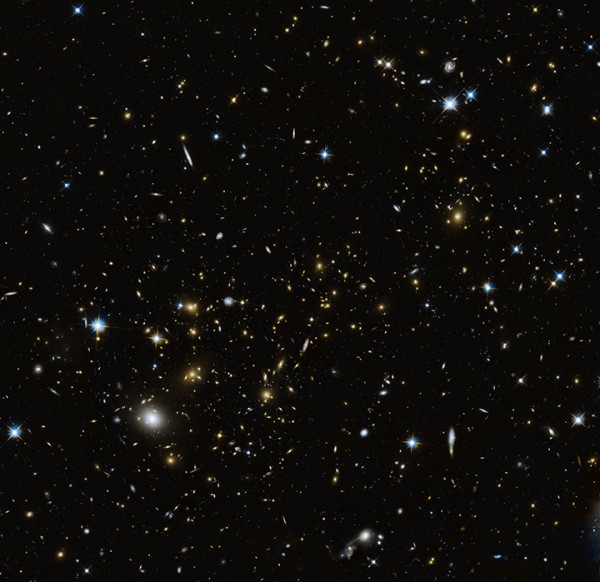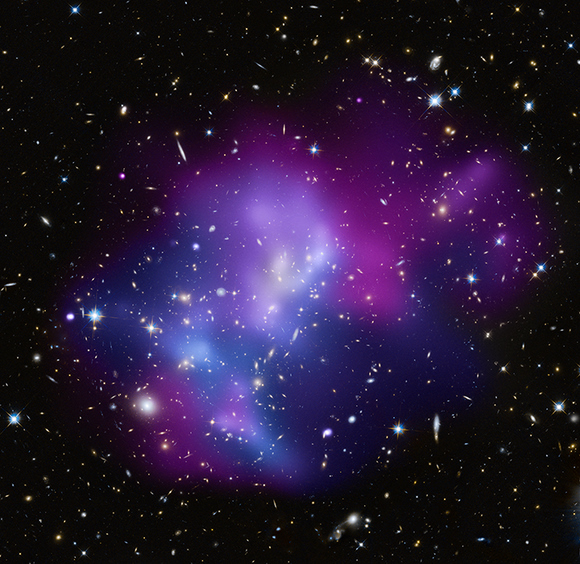It seems like it was just last week that I wrote about colliding dark matter, showing what happens when two galaxy clusters collide.
Well, nature has gone and one-upped me. Let me explain. Galaxy clusters are huge conglomerations of matter: normal matter (protons, neutrons, electrons, etc.) and dark matter (this mysterious, non-collisional stuff). We find them all over the place, and they can contain anywhere from a handful to thousands of galaxies. They are spectacular sights, and I'll give you one below.

But one thing these galaxy clusters do, even today, is continue to gravitationally grow. Gravity is an attractive force, and as long as the gravity from a galaxy cluster's normal and dark matter combined is strong enough, it will pull other galaxies and galaxy clusters in to it. Here are the results (and click the image to enlarge) of a big simulation of dark & normal matter growing in a galaxy cluster.

Do you notice how, as time goes on, the dense center of the cluster gets more massive as it attracts more and more of the matter around it in real life? And those little filamentary structures that come out of the central cluster? That's where more galaxies and galaxy clusters enter and merge into the large, central one. Well, we've found a real-life cluster, MACSJ0717, where three smaller clusters are the the process of merging with a much larger one. The cluster itself looks innocuous enough. Here's the optical data on its own.

But don't be fooled; this cluster is undergoing some terrible collisions. That's collisions, plural. The X-ray data overlayed here shows both hot and cool (purple and blue) gas that emit "hard" and "soft" X-rays. As you can see, it's all over the place.

But what this X-ray data -- combined with the optical -- lets us do is figure out where the individual parts of this cluster are moving. This allows us to identify the different components of it, and figure out how many different parts there are. The results? Video-riffic!
The next step? It's for a gravitational lensing team to take the optical data and recreate where the mass is, so we can see whether it lines up with the X-rays or not! You know, because you've read about it here, that the dark matter won't be where the X-rays are. But, we've never seen this many clusters collide before, and so we'd love to find out where the dark matter actually is! It may teach us something interesting and unexpected.
And while we're speaking about space news, you can find another article on this story at Universe Today, where you can also find the latest Carnival of Space!
- Log in to post comments

Hm, how exactly does the gravitational lensing team produce their result ?
after all we have just our vantage point and a circle with a multitude of points where each galaxy is seen, but no means to determine where it [the galaxy] actually is... [because it is a circle]...
how does that work? Is it some sort of a jigsaw - if you fit one and then you fit in the next galaxy, you have to adjust them judging by the new data ?
Given that dark matter seems to operate somewhat independently from normal matter in collisions, has dark matter ever been found in the absence of normal matter (cast off from a collision, perhaps)?
They would use distortions to the shapes of the background galaxies. They don't know the true shape of any given background galaxy, but they do know what the statistical distribution of shapes should be (e.g. randomly oriented), and can look for variations from that distribution.
Since "dark matter" is detectable only by gravitational effects, and doesn't seem to "collide" with that relatively rare stuff called ordinary matter - wouldn't it make slightly more sense to call it dark mass?
(Yeah, I know, this would put the Vatican's astronomers in a bit of a bind, terminologically speaking... but is that a bug or a feature? After all, Russian-speaking astronomers have somehow learned to live with "black hole", despite its other meaning in their language.)
Andrew is right. We look at the background galaxies and see if, on average, they're oriented randomly, or if they're skewed at all. If they're skewed, we call that effect "weak gravitational lensing", and that tells us about the total intervening mass.
Dark matter has undergone a number of different names. It was first referred to as the "missing mass" problem, and then a group decided to call it the "missing light" problem, since the mass was there but the light wasn't. Dark matter caught on over a decade ago, and it doesn't look like it's going to change. Anything with mass is called "matter" anyway.
What will result of these collisions? Will they all coalesce, colapse and form super-duper black-holes?